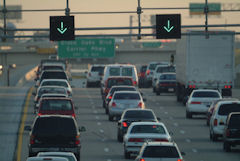The recession may have provided a temporary respite in traffic congestion — people tend to drive less when they’re not working, and trucks move less freight — but the picture will worsen rapidly when economic recovery takes hold. So say the authors of the 2011 Urban Mobility Report published by the Texas Transportation Institute.
The national picture will play out in Virginia’s three metropolitan areas included in the study. The congestion relief provided by the recession for the Washington, Hampton Roads and Richmond regions has largely evaporated already. The picture is especially bleak for Richmond, once one of the least congested of the nation’s largest metro areas, whose ranking in the national congestion standings continues to rise.
The Urban Mobility Report is simultaneously a highly useful exercise in documenting the cost of traffic congestion in the United States and a disturbing part of the problem. On the one hand, the range of data it collects is the most extensive and authoritative anywhere and, for all of its limitations, it remains the best gauge we have for measuring congestion and its costs. On the other hand, the authors persist in the belief that a Texas-styled approach of building more roads will get us out of the mess we have created.
To be sure, the authors advocate a “balanced” approach that includes investing in mass transit, traffic management strategies such as signal coordination and rapid crash removal, and demand management strategies like telecommuting and flexible work hours. And they add, “Land use and development patterns can play a positive role, as well.” But the report perpetuates the belief that regions can build their way out of their congestion woes. “If you invest in roads and transit, you get better service and access to more jobs,” says co-author Tim Lomax. “Generally speaking, mobility investments in congested areas have a high return rate.”
Lomax offers no evidence to justify that last statement. The truth is, many projects are driven by political considerations in the total absence of Return on Investment analysis. Moreover, the complex interplay between transportation and human settlement patterns means that the rate of return is exceedingly difficult to ascertain even if some one tried to perform an analysis. Yes, Virgina does need to invest more in transportation. The trick is figuring out which investments to make. Dumping billions of dollars into “doing something” on the grounds that it’s better than doing nothing could, in fact, be worse than doing nothing if we put money into the wrong projects.
With those caveats, let’s look at the picture in Virginia’s largest metro regions…
Washington metro area: 68% of the region’s arterial and interstate lane-miles and 84% of vehicle miles traveled (VMT) are congested during periods of peak travel. (“Rush hour” lasts seven hours each day.) The cumulative delay per person is 74 hours yearly and the cost per commuter in time and fuel is $1,495.
Virginia Beach metro area: 44% of the region’s arterial and interstate lane-miles and 50% of VMT are congested during periods of peak travel. (Rush hour lasts four hours each day.) The cumulative delay per person is 34 hours yearly and the cost per commuter in time and fuel is $654.
Richmond metro area: 36% of the region’s arterial and interstate lane-miles and 33% of VMT are congested during periods of peak travel. (Rush hour lasts 2.5 hours each day.) The cumulative delay per person is 20 hours yearly and the cost per commuter in time and fuel is $375.
To me, the big story is the continually worsening situation in the Richmond region. No one needs to tell Northern Virginians and Hampton Roadsters that they have huge traffic problems but, except in spot locations, congestion has yet to become a major concern of Richmonders. Accordingly, Richmond political and civic leaders perpetuate dysfunctional human settlement patterns. But congestion is steadily worsening and will become a major problem in the foreseeable future. In 2005, Richmond was ranked 88th among 101 metro areas by the cost of congestion per commuter. In 2010, it ranked 68th. The number of congested lane-miles has increased from 30% five years ago to 36% in 2010. The percentage of vehicle miles driven increased from 28% to 33%.
And why is that? The Richmond region is sprawling faster than almost any other region in Virginia, opening up more land for development, building at lower densities and perpetuating the pod form of development with disconnected and segregated cul de sacs, office parks and shopping centers. While our civic leaders focus on panaceas like high-speed passenger links to Raleigh and Washington, they remain blissfully unaware as builders and developers, working within the parameters set by government, pour billions of dollars into outmoded human settlement patterns. Will we be the last region in America to wake up and see how we are suffocating our future?



